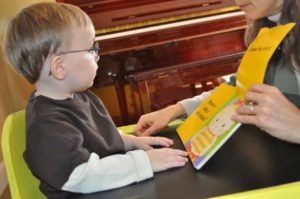
by Bryan Moles
As Stratton and Wright (1991, pp xixii) succinctly state: “literacy begins to develop at birth; it does not wait until a child reads his first word or even until he opens his first book. Literacy is a basic process, set in motion long before actual reading and writing take place, and it involves all of the child’s development.” Just as infants seem to have a myriad of needs at any given time, literacy skills are composed of a myriad of developmental milestones, starting in infancy.
The Braille Readiness Grid (McCominsky, 1996) lists developmental milestones divided into five categories: tactile, fine motor, listening/attention/exploring, concept building, book/story skills. Each of these categories have milestones that must be promoted in order to encourage literacy skills. The grid functions as a tool that all service providers and those in the home can work on; highlighting currently observed behaviors and providing guidance on emerging and sequential developmental order for further skills. The grid assigns no age specific goals for the milestones, and while it is designed for students who will likely be learning braille, the grid could easily be adapted by a DTV for a student who might need large print or who will be using functional literacy. Many of the milestones highlighted and emphasized are seemingly unrelated to literacy skills, but they emphasize the global nature that is literacy, no matter the medium of the words.
Stratton (1996) highlights two component of emergent literacy specifically for infants including reading aloud and the concept of symbols. Stratton compiled research that lays out the need for foundational reading aloud practices from infancy. Further, the early conceptual understanding of symbols emerges during infancy. Ferrell (2011) lists numerous uses of symbol making for use with infants, e.g. a certain blanket for nap-time, a plastic plate for snack time. While she does not continually link the symbolmaking to emerging literacy, this is a key milestone for meaning making.
Ferrell (2011) does list some specific emergent literacy skills that should be integrated into the daily routines of an infant with visual impairments. This pair reading is the same foundational activity that Stratton (1996) emphasized.
While it is easy to talk about how parents, caregivers and service providers should have all these tactile resources to promote early literacy, Craig’s (1999) research highlighted the difficulty in cultivating access to literacy materials early on. Craig was realistic in showing how limited resources for tactile experience books affects child literacy. Ferrell lists numerous resources that parents can avail themselves of, but they are often for a cost. DTVs must connect parents
References
Craig, C. (1999, December). Research Note Home Literacy Experiences of a Child with a Visual Impairment. Journal of Visual Impairment and Blindness, 93(12), 794797.
Ferrell, K. A. (2011). Reach out and teach: Helping your child who is visually impaired learn and grow. New York, NY: AFB Press.
McCominsky, A. (1996, May/June). The Braille Readiness Skills Grid: A Guide to Building a Foundation for Literacy. Journal of Visual Impairment and Blindness, 90, 3rd ser., 190193.
Stratton, J. M. (1996, May/June). Emergent Literacy: A New Perspective. Journal of Visual Impairment and Blindness, 90(3), 177183.
Stratton, J.M. & Wright, S. (1991). On the way to literacy: Early experiences for visually impaired children. RE:view, 23, 5561.